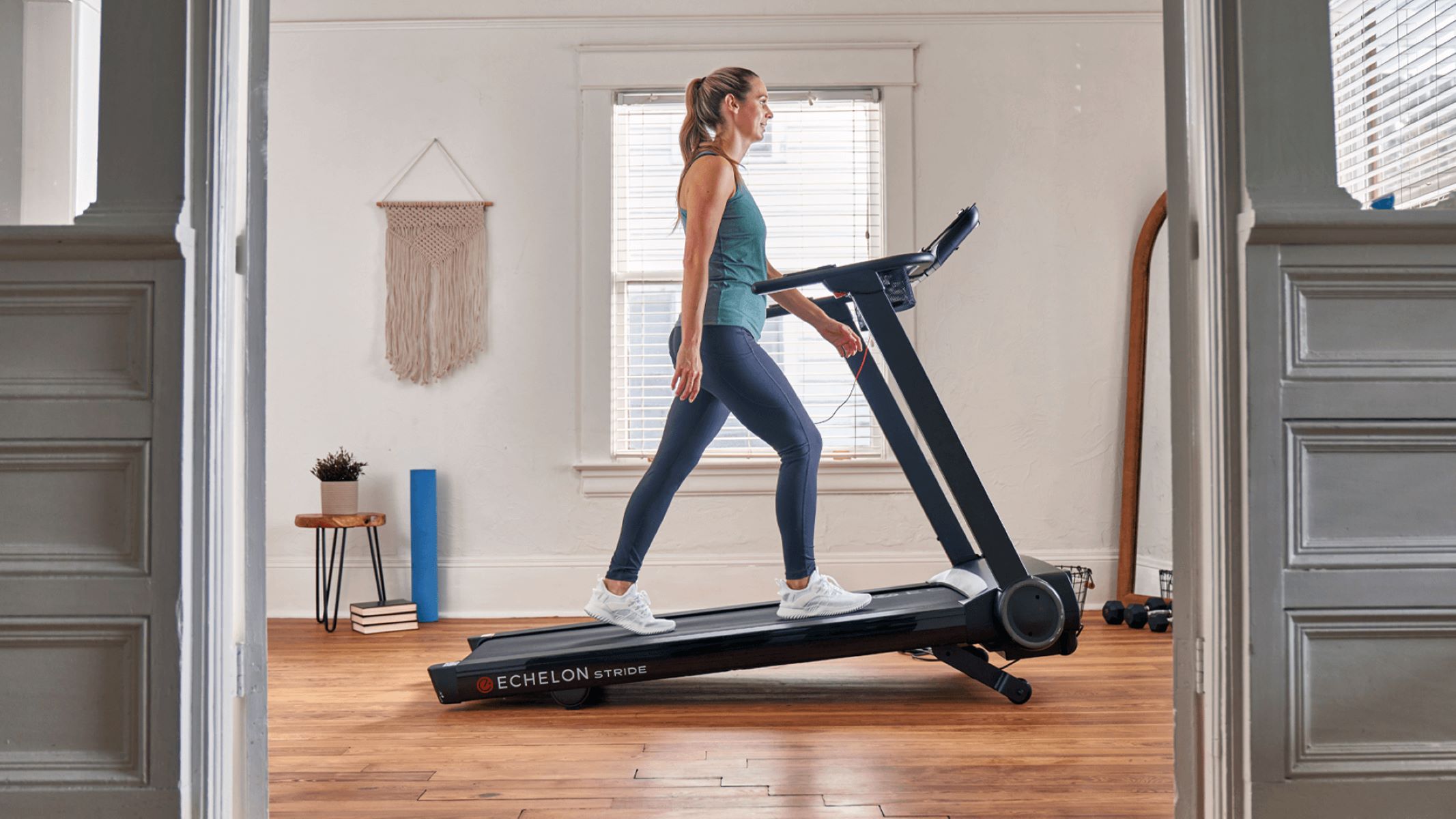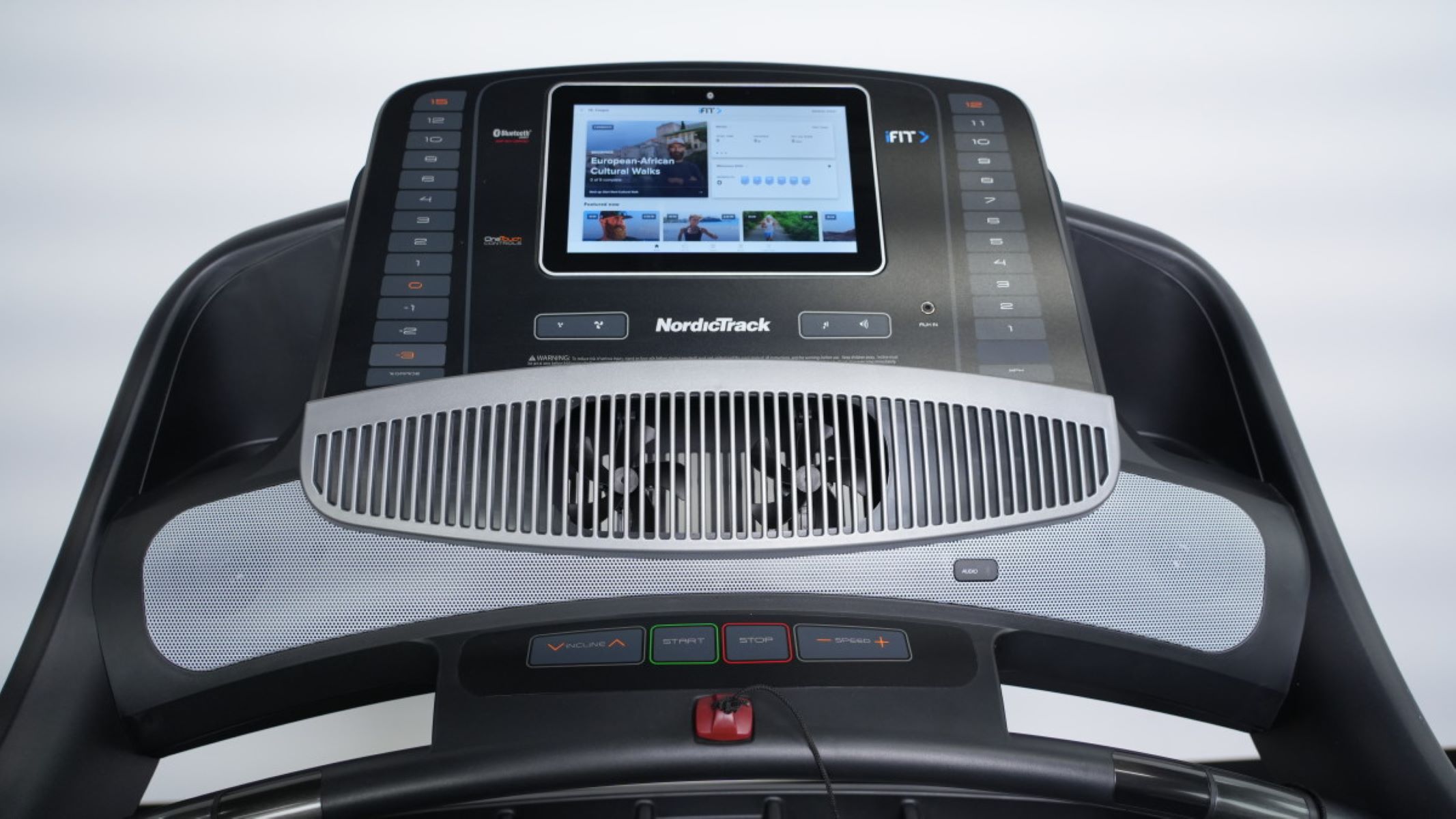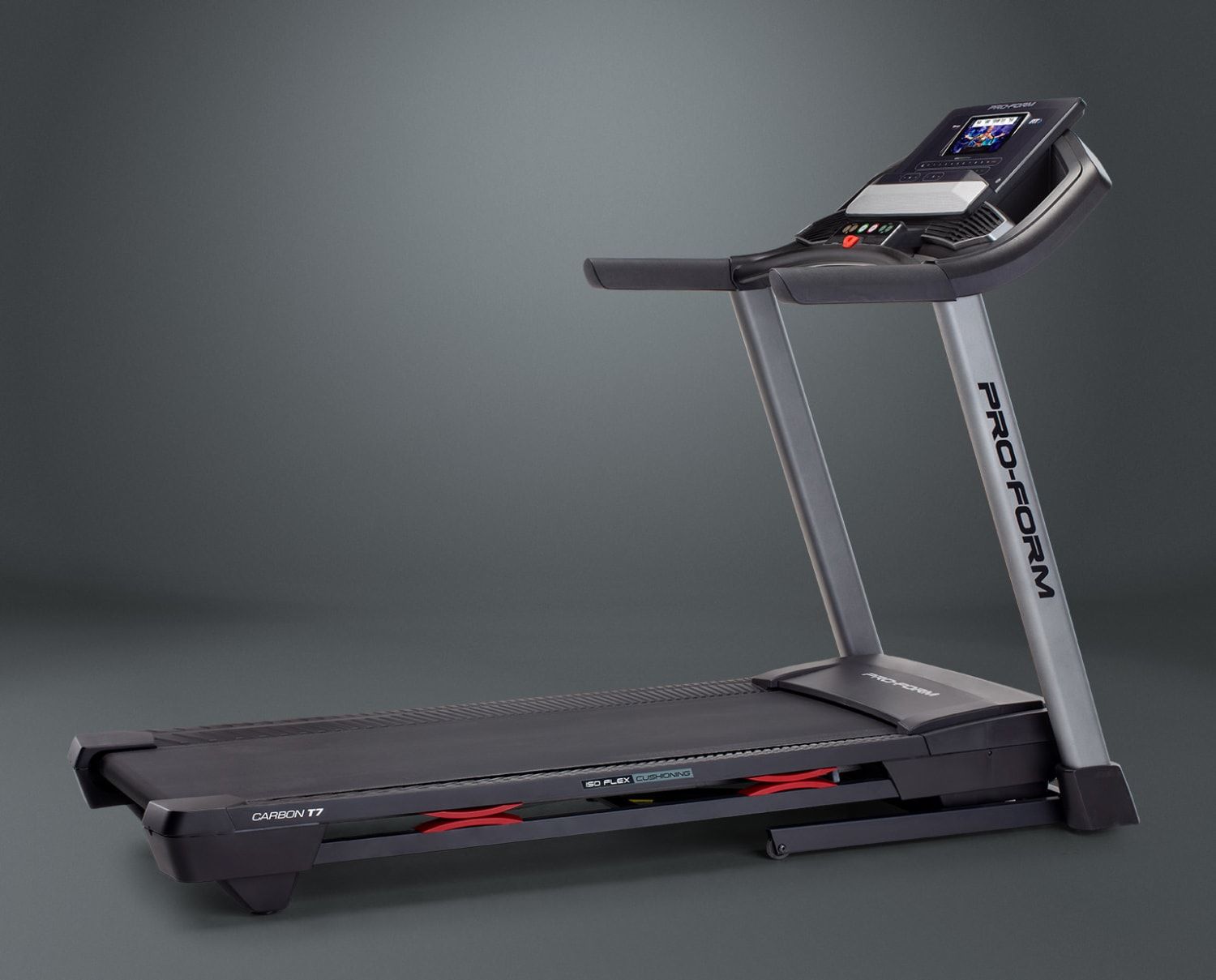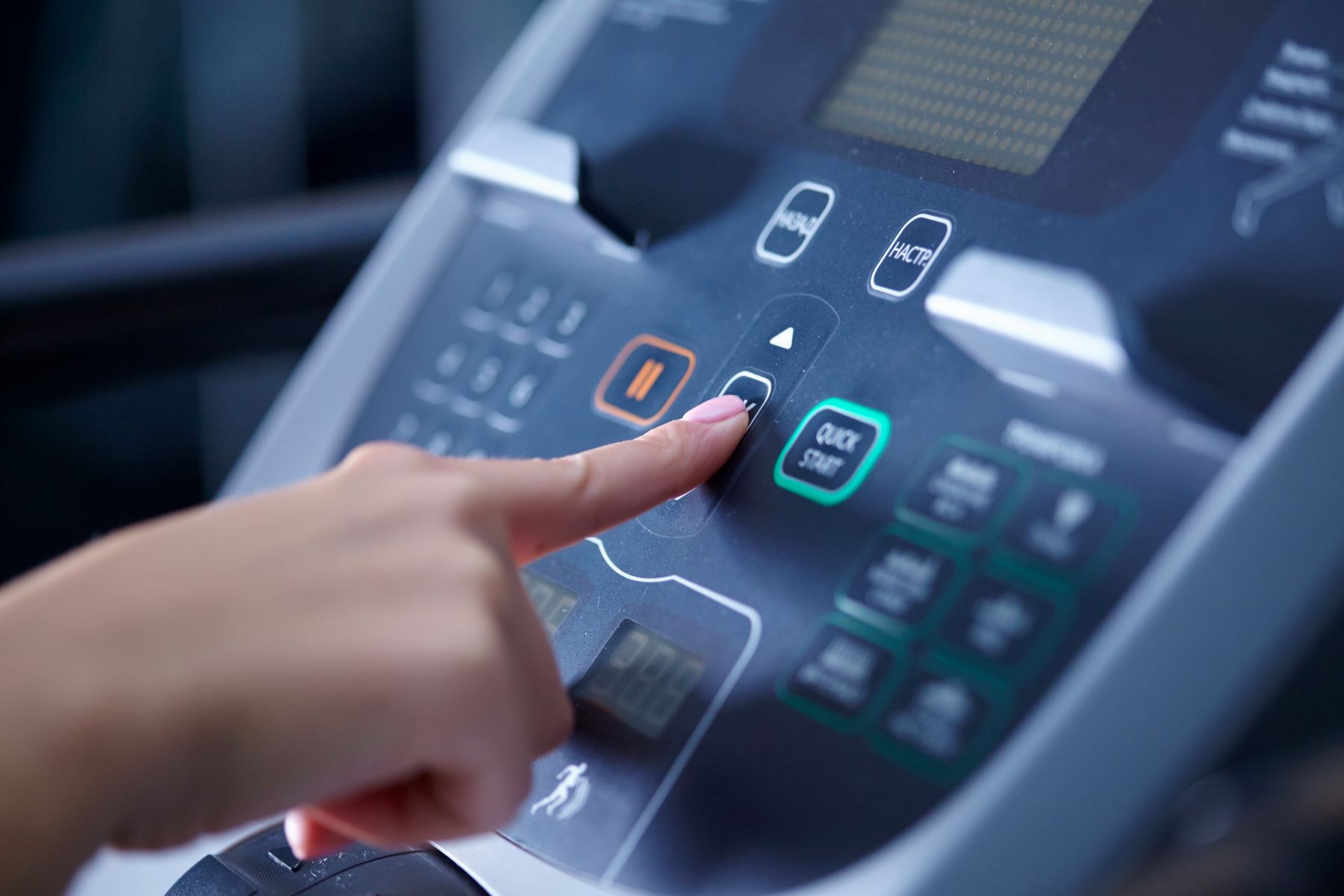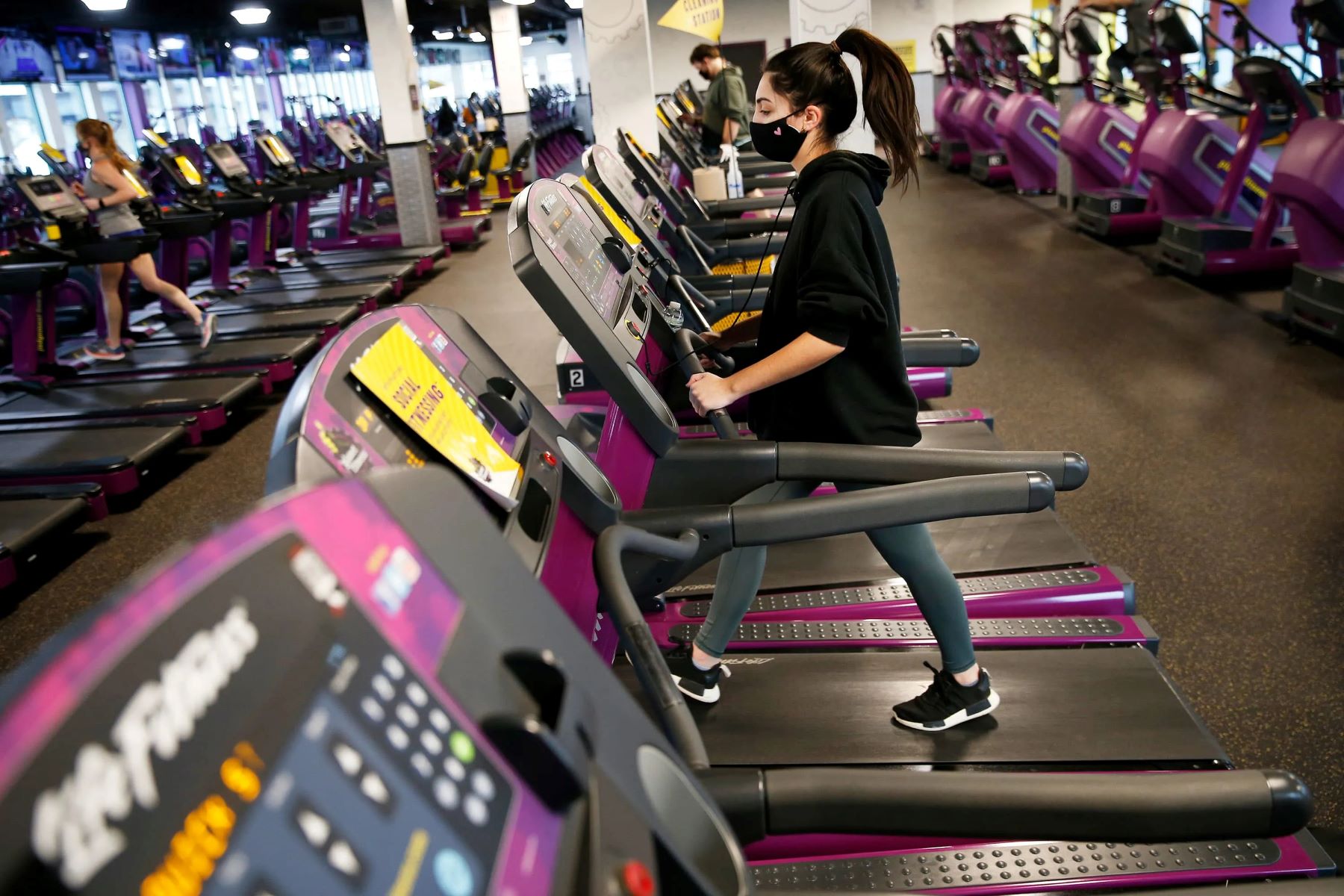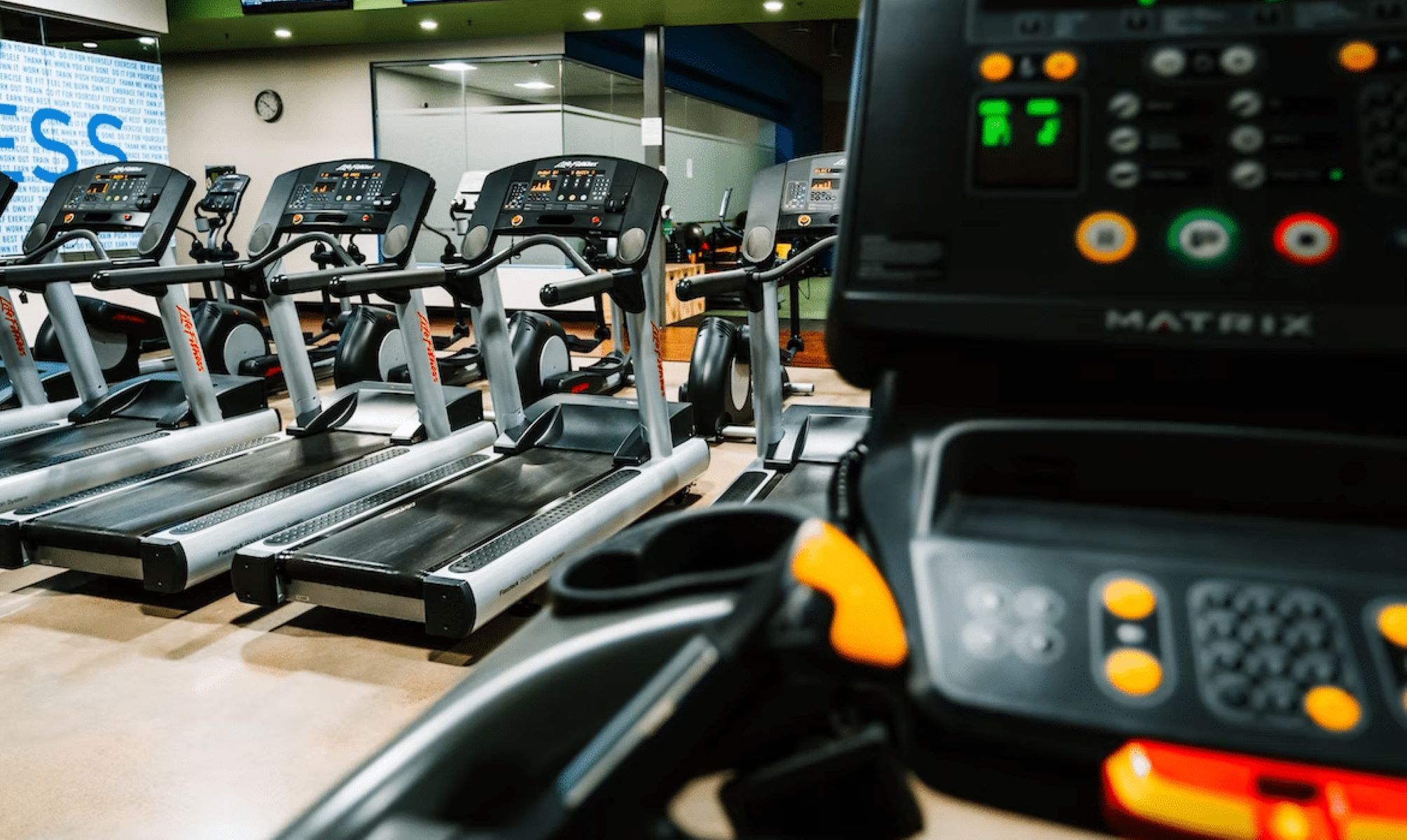

Featured
How To Start Jogging On Treadmill
Modified: August 21, 2023
Looking for a featured guide on how to start jogging on a treadmill? Discover the best techniques and tips to kick-start your fitness journey!
Introduction
Welcome to the world of treadmill jogging! Whether you’re a seasoned runner looking to switch up your routine or a beginner embarking on your fitness journey, jogging on a treadmill can be a convenient and effective way to get fit. This article will guide you through the process of starting your treadmill jogging routine, from choosing the right equipment to setting goals and staying motivated.
Jogging is a fantastic cardiovascular exercise that can help improve your endurance, strengthen your muscles, and boost your overall fitness level. Running on a treadmill provides you with the opportunity to jog in the comfort of your own home or at the gym, regardless of the weather outside. It also allows you to easily track your speed, distance, and calories burned, making it easier to monitor your progress and set achievable goals.
Before diving into the world of treadmill jogging, it’s important to understand the benefits of this exercise and its impact on your health. Not only does jogging on a treadmill provide a great workout for your heart and lungs, but it also helps in burning calories and shedding unwanted pounds. It can improve your mood and reduce stress levels, providing a welcome mental boost during your workouts.
As with any exercise program, it’s crucial to start slowly and gradually increase the intensity of your workouts. This article will provide you with the information you need to get started, including choosing the right treadmill, setting it up correctly, and warming up before your jog. We’ll also cover important topics such as maintaining proper form, monitoring your heart rate, cooling down after your run, and setting goals to track your progress.
So, are you ready to lace up your sneakers and hit the treadmill? Let’s dive in and discover the exciting world of treadmill jogging and how it can transform your fitness journey!
Benefits of Jogging on a Treadmill
Jogging on a treadmill offers a multitude of benefits for both experienced runners and beginners alike. Whether you’re looking to improve your cardiovascular fitness, lose weight, or simply stay active, incorporating treadmill jogging into your routine can help you achieve your goals. Let’s explore some of the key benefits of this form of exercise.
- Convenience: One of the biggest advantages of treadmill jogging is its convenience. With a treadmill at home or a gym, you have the flexibility to jog at any time, regardless of the weather conditions outside. This eliminates the need to plan your runs around the unpredictability of the weather and allows you to maintain a consistent exercise routine.
- Controlled Environment: Jogging on a treadmill provides a controlled environment where you can easily adjust the speed, incline, and resistance to suit your fitness level. This allows you to tailor your workouts to your specific needs, whether you’re looking to challenge yourself with an uphill run or incorporate intervals of speed training.
- Joint-Friendly: Running on a treadmill is generally considered to be more joint-friendly compared to running on hard surfaces, such as concrete or pavement. The cushioning provided by the treadmill deck absorbs some of the impact, reducing the stress on your joints and minimizing the risk of injury.
- Improved Cardiovascular Health: Jogging on a treadmill is a fantastic cardiovascular exercise that gets your heart pumping and your blood flowing. Regular treadmill workouts can help improve your heart health, strengthen your cardiovascular system, and increase your endurance over time.
- Weight Loss: If weight loss is one of your goals, treadmill jogging can be an effective tool in your weight management journey. By incorporating high-intensity intervals or longer runs into your routine, you can burn a significant amount of calories and help create a calorie deficit, which is essential for weight loss.
- Mental Well-being: Engaging in regular exercise, such as treadmill jogging, has been shown to have a positive impact on mental health and well-being. It can help reduce stress, boost mood, alleviate symptoms of anxiety and depression, and improve overall cognitive function.
- Progress Tracking: Most modern treadmills come with built-in features that allow you to track various metrics, such as distance covered, speed, pace, calories burned, and heart rate. This makes it easier to monitor your progress, set goals, and make adjustments to your workouts as needed.
By taking advantage of these benefits, you can make treadmill jogging an enjoyable and effective part of your fitness routine. Whether you’re looking to improve your overall health, enhance your running performance, or simply have a convenient and controlled way to stay active, jogging on a treadmill can be your go-to exercise option.
Choosing the Right Treadmill
When it comes to choosing a treadmill for jogging, there are several factors to consider. Investing in the right treadmill will not only enhance your running experience but also ensure long-term durability and functionality. Here are some key aspects to keep in mind when selecting the perfect treadmill for your needs.
- Budget: Determine your budget range before starting your search for a treadmill. Treadmills vary in price, ranging from basic models to high-end ones with advanced features. Set a budget that aligns with your financial means and look for treadmills within that range.
- Treadmill Type: There are two main types of treadmills: manual and motorized. Manual treadmills rely on your own leg power to move the belt, offering a more challenging workout but requiring a greater effort. Motorized treadmills, on the other hand, are powered by an electric motor, allowing you to adjust the speed and incline at the touch of a button. Consider which type suits your preferences and fitness goals.
- Running Surface: The size and quality of the running surface are crucial factors to consider. Look for a treadmill with a wide and long enough surface to accommodate your stride comfortably. Opt for a textured and cushioned surface that absorbs impact and reduces the strain on your joints.
- Motor Power: The motor power determines the performance and durability of the treadmill. Look for a treadmill with a motor power of at least 2.5 continuous horsepower (CHP) for jogging purposes. This ensures smooth operation even during intense workouts and enables the treadmill to withstand heavy usage over time.
- Incline and Speed Settings: Consider the incline and speed settings available on the treadmill. Most treadmills offer adjustable incline levels to simulate uphill or downhill running, which can add variety and intensity to your workouts. Additionally, choose a treadmill with a wide range of speed settings to cater to your jogging pace and future fitness goals.
- Console and Features: Look for a treadmill with an intuitive and easy-to-use console that displays essential workout metrics such as time, speed, distance, and calories burned. Consider additional features such as built-in workout programs, heart rate monitoring, audio connectivity, and compatibility with fitness apps if they align with your preferences and goals.
- Space and Storage: Assess the available space in your home or gym and choose a treadmill that fits your designated area. Consider the dimensions of the treadmill, especially when folded (if applicable), to ensure it can be stored conveniently when not in use.
- Warranty and Customer Service: Check the warranty offered by the treadmill manufacturer. A longer warranty period signifies the manufacturer’s confidence in their product’s quality. Additionally, read reviews and assess the customer service reputation of the brand to ensure reliable post-purchase assistance.
By carefully evaluating these factors, you can choose a treadmill that meets your requirements and provides a comfortable and effective jogging experience. Remember to compare different models, read reviews, and try out treadmills whenever possible to make an informed decision. Investing in the right treadmill will ensure enjoyable and consistent workouts for years to come.
Setting Up the Treadmill
Once you’ve chosen the perfect treadmill, it’s time to set it up for your jogging sessions. Proper setup ensures optimal performance, safety, and longevity of the equipment. Follow these steps to set up your treadmill effectively:
- Location: Choose a suitable location for your treadmill. Ensure the area has enough space for you to comfortably walk around the treadmill during workouts and allows for proper ventilation.
- Leveling: Use a leveling tool to ensure your treadmill is perfectly level. Adjust the leveling feet or wheels on the treadmill to achieve a stable and even surface.
- Power Source: Locate a nearby power outlet to plug in your treadmill. Make sure the outlet is easily accessible and can handle the power requirements of the treadmill.
- Safety Key: Attach the safety key to the console of your treadmill. This key acts as a safety measure and should be worn by the user during the exercise. It automatically stops the treadmill if the user falls or moves away from the console.
- Belt Alignment: Check the alignment of the treadmill belt. It should be centered and running straight. Make any necessary adjustments using the belt alignment controls provided by the manufacturer.
- Tension Adjustment: Adjust the tension of the treadmill belt if required. The belt should be taut but not too tight or loose. Consult the user manual for instructions on adjusting the belt tension.
- Emergency Stop Button: Familiarize yourself with the location of the emergency stop button on the treadmill. This button allows you to quickly stop the treadmill in case of an emergency or if you feel uncomfortable during your workout.
- Personal Settings: Set up any personalized settings on the treadmill console, such as age, weight, and preferred units of measurement. These settings will help accurately track your workout metrics and provide personalized feedback.
- Accessories: Consider adding accessories to enhance your treadmill experience. This could include a tablet or smartphone holder, a water bottle holder, or a towel rack for easy access to essentials during your workouts.
- Instruction Manual: Keep the treadmill instruction manual handy for reference. It provides valuable information on maintenance, troubleshooting, and safety guidelines that should be followed for proper treadmill usage.
By following these steps, you can ensure that your treadmill is properly set up for your jogging sessions. Remember to perform routine maintenance and keep the treadmill clean to prolong its lifespan. Now that your treadmill is ready to go, it’s time to warm up, put on your running shoes, and start your jogging routine!
Warming Up Before Jogging
Before diving into your treadmill jogging session, it’s crucial to warm up properly. Warming up prepares your body for exercise by increasing blood flow to your muscles, raising your core temperature, and loosening up your joints. Here are some essential steps to follow for an effective warm-up:
- Dynamic Stretches: Start your warm-up with dynamic stretches that involve active movements. This can include leg swings, arm circles, high knees, walking lunges, and hip circles. Dynamic stretches improve flexibility, increase range of motion, and activate the muscles you’ll be engaging during your jog.
- Light Cardio: Perform 5-10 minutes of light cardiovascular exercise to gradually increase your heart rate and warm up your muscles. This can be achieved through brisk walking, slow jogging, or pedaling on a stationary bike. The purpose is to elevate your heart rate and warm up your muscles without exhausting yourself.
- Joint Mobilization: Dedicate some time to perform joint mobility exercises to lubricate your joints and minimize the risk of injury. This can include gentle rotations of your ankles, knees, hips, shoulders, and wrists. Aim for smooth and controlled movements to promote mobility and flexibility.
- Dynamic Movements: Incorporate dynamic movements that mimic the motions you’ll be performing during your jogging session. This can include walking lunges, high knees, butt kicks, or skipping. These movements help activate your muscles and prepare them for the upcoming workout.
- Gradual Increase in Intensity: Throughout your warm-up, gradually increase the intensity of your movements. Begin with gentle movements and progress to slightly more challenging exercises. This gradual progression allows your body to adapt and minimizes the risk of injury.
- Breathing Exercises: Practice deep breathing exercises during your warm-up to help increase oxygen flow to your muscles and promote relaxation. Inhale deeply through your nose, filling your lungs, and exhale fully through your mouth. Focus on deep, slow breaths to oxygenate your body and calm your mind.
- Stay Hydrated: Make sure to hydrate yourself adequately before starting your warm-up. Drink water to ensure your body is properly hydrated, as this will contribute to better performance and prevent dehydration during your jog.
- Listen to Your Body: Pay attention to how your body feels during the warm-up. If you experience any pain or discomfort, modify or skip certain exercises. It’s important to listen to your body and not push beyond your limits during the warm-up phase.
Remember, the warm-up phase is not the time to exhaust yourself. It’s designed to prepare your body and mind for the upcoming jogging session and reduce the risk of injury. Take your time and focus on proper form and technique during each warm-up exercise. Once you’ve completed your warm-up, you’re ready to step onto the treadmill and start jogging!
Starting Slowly and Building Stamina
When beginning your treadmill jogging journey, it’s essential to start slowly and gradually build your stamina. Pushing too hard or too fast can lead to injuries and discouragement. Follow these tips to progress safely and effectively:
- Warm-Up Properly: Always start with a thorough warm-up, as mentioned in the previous section. Warming up prepares your muscles, joints, and cardiovascular system for the increased demands of jogging.
- Choose an Appropriate Speed: Set your treadmill at a comfortable jogging pace that allows you to maintain good form and control. It’s better to start at a slower speed and gradually increase it as you become more comfortable and confident.
- Pay Attention to Form: Focus on maintaining proper form while jogging. Keep your head up, shoulders relaxed, and core engaged. Avoid leaning forward or slumping, as it can put unnecessary strain on your back and reduce your efficiency.
- Find Your Rhythm: Tune into your body and find a comfortable rhythm that suits your fitness level. Start with a cadence that allows you to breathe comfortably and gradually increase it as you become more conditioned.
- Incorporate Intervals: Once you’ve established a consistent jogging routine, consider incorporating intervals into your workouts. Alternate between periods of slightly faster running or increased incline with recovery periods. Interval training is an excellent way to build endurance and challenge your cardiovascular system.
- Gradually Increase Time and Distance: Aim to gradually increase the duration and distance of your treadmill jogs. Start with shorter sessions and slowly add a few minutes to your jogging time each week. Similarly, gradually increase the distance you cover during your workouts. This progressive approach allows your body to adapt and build stamina over time.
- Listen to Your Body: It’s vital to listen to your body and avoid overexertion or pushing through pain. If you feel any discomfort or excessive fatigue, take a break or reduce the intensity of your workout. Rest days and recovery periods are just as important as the workout itself in preventing injury and allowing your body to adapt and improve.
- Set Realistic Goals: Set realistic and achievable goals for yourself. Whether it’s increasing your jogging time, reaching a specific distance, or improving your overall fitness level, having clear goals can help keep you motivated and focused on your progress.
- Stay Consistent: Consistency is key when it comes to building stamina. Aim to incorporate treadmill jogging into your weekly routine, whether it’s three times a week or more. Consistency allows your body to adapt and improve gradually.
Remember, building stamina takes time and patience. Don’t compare yourself to others and focus on your own progress. Celebrate each milestone along the way, whether it’s running an extra minute or reaching a new distance record. With perseverance and a gradual approach, you’ll steadily build your stamina and achieve your jogging goals.
Establishing a Steady Pace
Establishing a steady pace while jogging on a treadmill is essential for maintaining proper form, increasing endurance, and maximizing the benefits of your workout. Here are some tips to help you establish and maintain a consistent and effective pace:
- Find Your Comfort Zone: Begin by finding a pace that feels comfortable and sustainable for you. It should be a pace at which you can carry on a conversation without feeling out of breath. This will vary depending on your fitness level and goals.
- Use the Rate of Perceived Exertion (RPE): The Rate of Perceived Exertion scale is a subjective measure of how hard you feel like you’re working. Use this scale to gauge your effort level and adjust your pace accordingly. Aim for an RPE of around 5-6 on a scale of 1-10, which represents a moderate intensity workout.
- Focus on Breathing: Pay attention to your breathing while jogging. Breathe deeply and rhythmically, inhaling through your nose and exhaling through your mouth. Establishing a consistent and controlled breathing pattern can help maintain a steady pace and enhance your endurance.
- Use a Metronome or Music: Consider using a metronome or playing music with a consistent beat to help establish and maintain a steady pace. Set the metronome or choose songs with a tempo that matches your desired pace. This external rhythm can help you stay on track and synchronize your steps.
- Monitor Your Heart Rate: Monitoring your heart rate can be a useful tool for establishing a steady pace. Aim for a heart rate within your target zone, which is typically 50-85% of your maximum heart rate. This helps ensure that you’re working at an appropriate intensity level and not overexerting yourself.
- Use the Talk Test: Another method to gauge your pacing is the talk test. If you can speak comfortably in full sentences without gasping for breath, you’re likely at a sustainable pace. If you can only manage short phrases or single words, you may be pushing too hard.
- Gradually Increase Your Pace: Once you’ve established a comfortable pace, you can gradually increase it over time. Every few weeks, aim to slightly pick up the pace or increase the incline to challenge yourself and improve your endurance. Make these adjustments gradually to avoid overexertion or injury.
- Stay Mindful: Concentrate on maintaining your form and staying mindful of your pace. Avoid getting carried away by distractions or increasing your speed too quickly. Stay present and focused on your body and breathing to maintain a steady and efficient workout.
- Track Your Progress: Use the built-in tracking features of your treadmill or a fitness tracker to monitor your progress. Keep a record of your pace, distance covered, and any other relevant metrics. This will allow you to see how your pace improves over time and motivate you to continue challenging yourself.
By establishing and maintaining a steady pace, you’ll optimize your treadmill jogging experience and reap the benefits of increased endurance and improved fitness. Remember to listen to your body, be patient with yourself, and make incremental adjustments as you progress. Consistency and a mindful approach will help you develop a strong and efficient running pace.
Maintaining Proper Form
Maintaining proper form while jogging on a treadmill is crucial for efficiency, injury prevention, and getting the most out of your workout. Poor form can lead to discomfort, fatigue, and potential long-term injuries. Here are some tips to help you maintain proper form while jogging on a treadmill:
- Posture: Stand tall and avoid slouching or hunching over. Keep your head up, your shoulders relaxed, and your chest open. Good posture allows for efficient breathing and helps distribute the impact of each footstrike evenly.
- Arms: Keep your arms relaxed and bent at a 90-degree angle. Your arms should swing naturally, moving forward and backward in sync with your stride. Avoid crossing your arms in front of your body, as this can throw off your balance and reduce efficiency.
- Hands and Fists: Keep your hands loose and relaxed. Avoid clenching your fists, as it can create unnecessary tension in your upper body. Imagine holding an egg or a delicate item to encourage a light grip.
- Core Engagement: Engage your core muscles by gently pulling your naval towards your spine. This helps stabilize your torso and maintain overall body alignment. A strong core improves balance and running efficiency.
- Footstrike: Aim for a midfoot or forefoot strike rather than a heel strike. Landing on your midfoot or forefoot promotes a more natural running gait and reduces the impact on your joints. Avoid overstriding, which can lead to inefficient and jarring foot landings.
- Cadence: Strive for a quick and efficient turnover of your feet. Aim for a cadence of around 170-180 steps per minute, as a higher cadence can reduce the strain on your body and promote a smoother running motion.
- Foot Lift: Lift your feet just enough to clear the surface of the treadmill. Avoid excessive foot lift, which wastes energy and can lead to an inefficient running form.
- Breathing: Breathe deeply and rhythmically. Inhale through your nose and exhale through your mouth to ensure a steady flow of oxygen to your muscles. Establishing a controlled breathing pattern can help you maintain your form and endurance.
- Avoid Overstriding: Overstriding occurs when your foot lands too far in front of your body, leading to a braking effect and increased impact on your joints. Focus on maintaining a shorter stride length and landing your foot closer to your body’s center of gravity.
- Relaxation: Strive for a relaxed and fluid running motion. Avoid unnecessary tension in your body, especially in your shoulders, neck, and face. Relaxing your muscles helps conserve energy and promotes a more efficient and enjoyable running experience.
Maintaining proper form may require conscious effort and practice. It’s important to listen to your body and make adjustments as needed. Regularly checking in with your form during your treadmill jogging sessions can help you develop good habits and prevent the development of bad ones. Over time, proper form will become more natural and second nature.
Monitoring Heart Rate
Monitoring your heart rate while jogging on a treadmill is an effective way to gauge your exercise intensity and ensure you’re within your target heart rate zone. It allows you to optimize your workout, track your progress, and make adjustments to your speed or incline as needed. Here are some tips for monitoring your heart rate during treadmill jogging:
- Know Your Target Zone: Determine your target heart rate zone based on your age and fitness level. Generally, the target zone is around 50-85% of your maximum heart rate. This range ensures that you’re working at an appropriate intensity level to achieve your fitness goals.
- Use a Heart Rate Monitor: Invest in a heart rate monitor or use the built-in heart rate monitor on your treadmill, if available. A heart rate monitor provides accurate real-time feedback on your heart rate, allowing you to make adjustments to your pace or incline to stay within your target zone.
- Check Your Pulse: If you don’t have a heart rate monitor, you can manually check your pulse during your workout. Stop jogging briefly, locate the pulse point on your wrist or neck, and count the number of beats in 15 seconds. Multiply that number by four to get your heart rate in beats per minute (bpm).
- Observe Your Breathing: Pay attention to your breathing during your treadmill jog. If you can still carry on a conversation without feeling excessively breathless or struggling to speak, you’re likely within your target heart rate zone. If you’re unable to speak comfortably, you may be working at a higher intensity.
- Experiment with Different Intensities: During your treadmill jogging sessions, experiment with different intensities and monitor how your heart rate responds. Increase the pace or incline and observe the corresponding change in your heart rate. This experimentation will help you better understand your body’s response to varying intensities.
- Consider Rate of Perceived Exertion (RPE): Use the Rate of Perceived Exertion scale to gauge your effort level. This subjective scale ranges from 1 to 10, with 1 being very light exertion and 10 being maximal effort. Aim to work within an RPE of 5-6, which corresponds to moderate intensity and aligns with your target heart rate zone.
- Monitor Resting Heart Rate: Track your resting heart rate over time to monitor changes in your cardiovascular fitness. A lower resting heart rate is often an indication of improved cardiovascular health and fitness levels. Measure your resting heart rate upon waking up in the morning before any physical activity.
- Consult a Healthcare Professional: If you have any concerns regarding your heart health or exercise intensity, consult with a healthcare professional, such as a doctor or a certified fitness trainer. They can provide specific guidance and help you establish appropriate heart rate targets based on your individual circumstances.
Monitoring your heart rate while jogging on a treadmill allows you to customize your workouts and ensure you’re working at an appropriate intensity for your goals and fitness level. It empowers you to make informed decisions about your exercise routine, maximize your cardiovascular benefits, and track your progress over time. By staying within your target heart rate zone, you’ll optimize the effectiveness and efficiency of your treadmill jogging sessions.
Cooling Down After Jogging
After completing your treadmill jogging session, it’s important to allow your body to gradually transition from exercise to a state of rest. Cooling down properly helps prevent muscle soreness, promotes recovery, and allows your body to return to its normal state. Here are some essential steps to include in your cooldown routine:
- Slow Down Gradually: Instead of abruptly stopping, gradually decrease the speed and intensity of your jogging. This allows your heart rate to gradually decline and prevents blood pooling in your extremities.
- Continue Jogging/Walking: After you’ve decreased the speed, continue to jog or walk at a slower pace for about 5-10 minutes. This aids in gradually lowering your heart rate and helps flush out metabolic waste products from your muscles.
- Static Stretching: Perform static stretches for the major muscle groups you used during your jog. Hold each stretch for 15-30 seconds without bouncing. Focus on the calves, quadriceps, hamstrings, hip flexors, and glutes.
- Deep Breathing: Incorporate deep breathing exercises during your cooldown. Take slow and deep breaths, inhaling through your nose and exhaling through your mouth. This helps promote relaxation and aids in lowering your heart rate.
- Foam Rolling or Self-Massage: Use a foam roller or perform self-massage techniques to target any areas of tightness or discomfort. This can help release tension in your muscles and improve circulation.
- Hydrate: Rehydrate your body by drinking water after your jog. Sweating during exercise leads to fluid loss, and replacing it is crucial for proper recovery and preventing dehydration.
- Reflect and Relax: Take a few minutes to reflect on your workout and acknowledge your efforts. Use this time to relax mentally and physically, allowing your body to fully recover.
- Post-Workout Stretching: After cooling down, engage in a more thorough stretching routine to enhance flexibility and improve muscle recovery. Focus on the entire body, paying attention to areas that may feel particularly tight or tense.
- Listen to Your Body: Be attentive to any discomfort or unusual sensations during the cooldown. If you experience any pain or swelling that persists after your workout, consult with a healthcare professional for appropriate guidance.
Remember, the cooldown phase should not be rushed or skipped. It plays a crucial role in helping your body recover and prevent muscle stiffness or soreness. By taking the time to properly cool down, you’ll not only reduce the risk of injury but also promote better overall recovery and readiness for your next workout.
Setting Goals and Tracking Progress
Setting goals and tracking your progress are essential components of any successful treadmill jogging routine. They not only provide motivation but also help you stay focused, measure your achievements, and make necessary adjustments to your workouts. Here are some tips for setting goals and effectively tracking your progress:
- Identify Your Why: Determine why you want to incorporate treadmill jogging into your fitness routine. It could be to improve cardiovascular health, increase endurance, lose weight, or simply maintain an active lifestyle. Understanding your underlying motivation will help you set meaningful goals.
- Make Your Goals Specific: Set specific and achievable goals rather than vague ones. Instead of saying, “I want to improve my jogging,” create specific goals such as “I want to jog for 30 minutes without stopping in two months” or “I want to complete a 5K race in the next three months.”
- Set Realistic Targets: Ensure that your goals are realistic and attainable based on your current fitness level. Setting overly ambitious goals can lead to frustration or even injury. It’s better to start with smaller goals and gradually increase their difficulty over time.
- Break Goals into Smaller Milestones: Divide your larger goals into smaller milestones. This allows you to track your progress more easily and creates a sense of accomplishment along the way. For example, if your goal is to jog for 30 minutes, start with a target of jogging for 10 minutes, then gradually increase the duration each week.
- Track Workout Metrics: Utilize the tracking features of your treadmill or a fitness tracker to monitor key workout metrics. Keep a record of distance covered, speed, time, calories burned, and average heart rate. Tracking these metrics helps you see your progress over time and provides tangible evidence of your achievements.
- Maintain a Workout Diary: Keep a workout diary or use a fitness app to log your treadmill jogging sessions. Include details such as date, distance, time, perceived exertion, and any other relevant observations. This diary serves as a comprehensive record of your progress and can help you identify patterns or areas for improvement.
- Regularly Reassess and Adjust: Periodically reassess your goals and adjust them as needed. As you progress, you may find that your initial goals may no longer challenge you or align with your current fitness level. Modify your goals to keep them stretching but attainable.
- Celebrate Milestones: Celebrate your milestones and achievements along the way. Recognize and reward yourself for reaching your goals, whether it’s treating yourself to a massage or purchasing new workout gear. Celebrating milestones reinforces your progress and motivates you to continue pushing forward.
- Seek Support and Accountability: Share your goals with others or find a workout buddy who can provide support and hold you accountable. Having someone to share your progress with and offer encouragement can significantly increase your motivation and commitment to your treadmill jogging routine.
- Be Patient and Stay Consistent: Remember that progress takes time. Stay patient, trust the process, and stay consistent with your workouts. Results may not happen overnight, but with dedication and persistence, you’ll see improvements and achieve your desired outcomes.
Setting goals and tracking your progress are vital for maintaining focus, staying motivated, and making continuous improvements in your treadmill jogging routine. By keeping your goals specific, measurable, achievable, and realistic, and consistently monitoring your progress, you’ll be well on your way to reaching new fitness heights and embracing the benefits of regular exercise.
Staying Motivated
Maintaining motivation is key to sustaining a consistent treadmill jogging routine. It’s normal to have ups and downs in your motivation levels, but there are strategies you can implement to stay motivated and committed to your fitness goals. Here are some tips to help you stay motivated throughout your treadmill jogging journey:
- Set Meaningful Goals: Ensure that your goals align with your values and aspirations. Setting goals that have personal significance can fuel your motivation and give you a sense of purpose in your treadmill jogging routine.
- Reward Yourself: Treat yourself with rewards when you achieve milestones or reach your goals. It can be something small like enjoying a relaxing bath, buying new workout gear, or indulging in a healthy treat. Rewards provide positive reinforcement and help create a positive association with your treadmill jogging sessions.
- Create a Support System: Surround yourself with a support system of friends, family, or fellow fitness enthusiasts who can provide encouragement, accountability, and motivation. Consider joining a running club, online community, or finding a workout buddy to share your journey with.
- Vary Your Workouts: Avoid monotony by incorporating variety into your treadmill jogging routine. Modify your speed, incline, or distance, or try interval training or different workout programs. Adding variety keeps your workouts fresh and prevents boredom or plateauing.
- Track Your Progress: Keep track of your progress and measure your improvements over time. Seeing tangible evidence of your hard work, such as increased endurance or faster running times, can boost your motivation and confidence.
- Visualize Success: Visualize yourself achieving your goals and experiencing the benefits of your treadmill jogging routine. Create a mental image of how you want to look and feel, and let that vision motivate you to push forward and stay committed.
- Break It Down: Break down your larger goals into smaller, manageable tasks. Focusing on smaller milestones allows you to experience success more frequently, which boosts motivation and makes your larger goals feel more attainable.
- Find Inspiration: Seek inspiration from various sources, such as books, articles, podcasts, or documentaries, that highlight the accomplishments of other runners or provide tips and techniques to enhance your running experience. Hearing success stories and learning from experienced runners can ignite your motivation.
- Track Non-Physical Benefits: Alongside physical progress, pay attention to the non-physical benefits of treadmill jogging. Notice improvements in your mood, stress levels, energy levels, or overall well-being. Acknowledging and appreciating these non-physical benefits can reinforce your motivation.
- Mix Up Your Playlist or Audiobooks: Curate a playlist of upbeat and motivational music or listen to inspiring audiobooks or podcasts during your treadmill jogging sessions. The right audio can invigorate your mind and energize your body, making your workouts more enjoyable.
- Practice Self-Care: Take care of yourself both physically and mentally. Prioritize sleep, eat nourishing foods, manage stress levels, and incorporate rest days into your routine. Taking care of your overall well-being plays a vital role in sustaining long-term motivation for your treadmill jogging routine.
Remember, motivation can fluctuate, but by implementing these strategies and finding what works best for you, you can stay motivated throughout your journey. Celebrate your progress, focus on the positive changes in your body and mind, and remember the countless benefits that regular treadmill jogging brings. With dedication, perseverance, and a positive mindset, you’ll maintain the motivation to keep lacing up your running shoes and conquering those workouts.
Conclusion
Congratulations on embarking on your treadmill jogging journey! By incorporating this convenient and effective exercise into your routine, you are taking a significant step towards improving your cardiovascular fitness, increasing endurance, and achieving your fitness goals. Throughout this article, we have explored the many benefits of treadmill jogging, from its convenience and joint-friendly nature to its ability to help with weight loss and improve mental well-being.
We discussed the importance of choosing the right treadmill that suits your needs and setting it up correctly for optimal performance. Warming up before each jogging session and maintaining proper form are essential for injury prevention and ensuring an efficient workout. Remember to monitor your heart rate, gradually increase your pace and distance, and cool down properly to aid in recovery.
Setting goals and tracking your progress will help you stay motivated and continuously challenge yourself. By maintaining proper form, monitoring your heart rate, and listening to your body, you can progress at a pace that is suitable for you. Take advantage of the variety and convenience that the treadmill offers, and keep your workouts engaging and enjoyable.
As you continue on your treadmill jogging journey, remember to stay patient, be consistent, and celebrate your achievements along the way. As your endurance and fitness level improve, consider exploring new challenges such as interval training, increasing your speed, or even participating in races or virtual running events.
Lastly, always listen to your body, be mindful of any discomfort or signs of overexertion, and consult with a healthcare professional if needed. Through perseverance and dedication, you can make treadmill jogging a rewarding and sustainable part of your fitness routine.
So, lace up your running shoes, hop on that treadmill, and let the journey towards better health and fitness begin!


